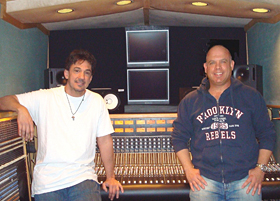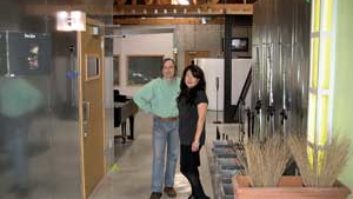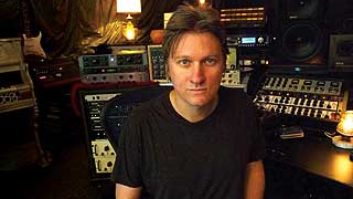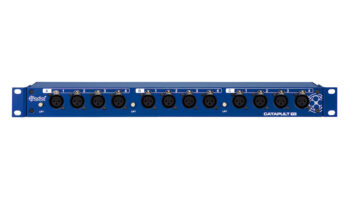
Chrome Dreams II.” />
Producer Nico Bolas (left) and engineer Scott Peets parked the Design FX truck to Neil Young’s garage to track Chrome Dreams II.
One of the big perks of working in a mobile recording studio is that every so often you get to make a really fun house call. Scott Peets, who has manned the tweaked-out vintage API board in the Design FX Remote truck since the early ’90s, recalls with particular fondness the week he spent at Neil Young’s ranch in 2007.
“Neil has a history with our truck from the ’70s, when it belonged to the Record Plant,” Peets explains. “He used the truck to record Ragged Glory in 1990, a year before [Design FX owner] Gary Ladinsky bought it. That record was cut in Neil’s barn, but I believe he sold that part of the property, so when it came time to record tracks for Chrome Dreams II, he and Niko Bolas, who co-produced and engineered, decided to put the band in the garage Neil uses to restore old cars. It has this retro-rustic vibe, with old gas pumps in front, a rotary phone — he doesn’t even like people using the Internet in the building.”
Converting the garage into a temporary recording studio — analog, naturally — required some temporary modifications. “They put in rubber flooring and filled in the holes with redwood chips,” Peets continues. “The remote truck was parked on the side of the building; they had two Studer 2-inch 827s in there with a Pro Tools backup, D-to-A converters — the truck was so packed that they built a makeshift extension on the back of it as a tape-storage locker. They called it ‘Plywood Digital.’”
More recently, the Design FX Remote crew drove from the company’s Burbank HQ to Austin to track Forgiven, the latest album from Los Lonely Boys, with Steve Jordan producing and Bolas engineering. “They brought in a P.A. and stage because they wanted to feel like they were in touring mode,” Peets recalls. “There was no pressure, no high-end studio vibe; it was like they were playing in their garage. They did the whole record that way, and they had a blast.”
Among Design FX Remote’s regular dates are KROQ’s Weenie Roast and Almost Acoustic Christmas concerts, the annual Andre Agassi Grand Slam for Children benefit and the Goldenvoice-produced Coachella Festival. The Coachella event, for which a best-of DVD is being assembled, is so massive that several trucks are required for wall-to-wall live-to-Web coverage, including one of Peets’ friendly rivals, Guy Charbonneau’s Carlsbad, Calif.-based Le Mobile. At the two-night Acoustic Christmas, which goes down at the Gibson Amphitheatre in Universal City, Design FX covers one of the rotating stages, and Westwood One’s Biff Dawes the other.
Sadly, righteous old-school recording projects like Chrome Dreams II and Forgiven are becoming less common for Design FX these days due to shrinking major-label budgets, the increased popularity of the flight pack and dramatically increasing venue fees, which max out at a staggering $100,000. Replacing those gigs are all sorts of DVD and film projects. Recent jobs include a 3-D movie of a Jonas Brothers concert at the Anaheim Honda Center and Rogue Wave film shot and recorded at the Cricket Amphitheatre in Chula Vista. “Everything we do nowadays is locked to picture, whether it’s film, hi-def video or regular video,” says Peets. “But that doesn’t matter to us; it’s all sound.”
Peets and his veteran crew recently spent several days at Sony Studios in Culver City, recording the music for Funny People, an upcoming Adam Sandler film featuring a fictional cover band. This isn’t just any band, however — Jon Brion, the musical director on the project, is the guitar player, and the legendary James Gadson is the drummer. “When I walked in, I noticed that James had paper towels taped all over the drums,” Peets says with a laugh. “It looked really strange, but it sounded great.”
The engineer/mixer’s pride and joy is the 44-input API board, one of the few in-line monitoring APIs in existence. The mainframe and 550A EQs date back to the original Record Plant installation, while in 1994, API specialists Jeff Bork and John Dressel teamed with the Design FX crew to design a custom compact input module.
“We record to dual Pro Tools HD systems,” Peets notes. “We use the Sigma timecode generator and a Brainstorm SR-15 Distripilyzer for timecode distribution. We reference the Pro Tools rigs to the Apogee Big Ben external clock. With dual rigs, we run one locked to the incoming timecode provided by the video truck and we’ll jam-sync the backup machine. If for some reason there’s a timecode dropout from the source generating the code, the Pro Tools will drop out of record. Jam-syncing the backup rig allows us to stay in record and still have the same timecode.”
He rattles off what’s in the rack: UREI, LA-2A, bx, Empirical Labs Distressors, a Neve 33609, a stereo GML EQ, Drawmer gates, an AMS reverb, a TC Electronic M-3000, Eventide H3000, SDE 3000 delay and a Sony reverb. The mic assortment includes Shure SM57s; AKG 414s and 451s; Neumann TLM 170s; Audio-Technica 4050s; and Sennheiser 421s, 609s and shotguns for recording the crowds. It doesn’t hurt that Design FX is a rental company.
“It’s like home to me,” Peets says of his studio on wheels. “I’ve worked at other studios, and I also mix over at Last Call With Carson Daly, and it’s surprising to me how great the imaging is in the truck. The API is so punchy. Kids come up when we’re doing these shows, and ask, ‘How’d you get it to sound so good?’ They’re used to listening to MP3s through earbuds, and when they hear this stuff their eyes get real big. It’s fun to watch.”
Send L.A. news to
[email protected].






